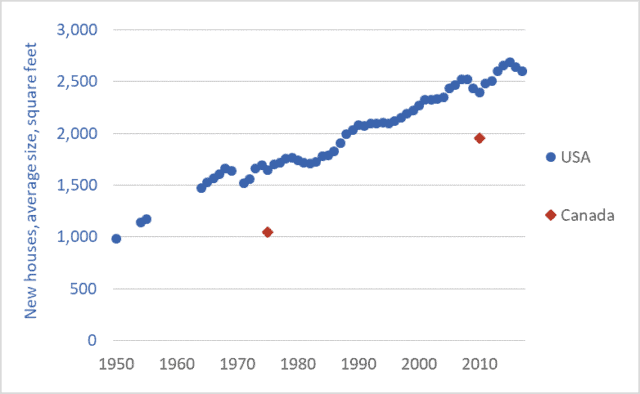I was an impressionable young boy back in 1971 when my parents were considering building a new home. I remember discussions about house size. 1,200 square feet was normal back then. 1,600 square feet, the size of the house they eventually built, was considered extravagant—especially in rural Saskatchewan. And only doctors and lawyers built houses as large as 2,000 square feet.
So much has changed.
New homes in Canada and the US are big and getting bigger. The average size of a newly constructed single-family detached home is now 2,600 square feet in the US and probably 2,200 in Canada. The average size of a new house in the US has doubled since 1960. Though data is sparse for Canada, it appears that the average size of a new house has doubled since the 1970s.
We like our personal space. A lot. Indeed, space per person has been growing even faster than house size. Because as our houses have been growing, our families have been shrinking, and this means that per-capita space has increased dramatically. The graph below, from shrinkthatfootprint.com, shows that, along with Australia, Canadians and Americans enjoy the greatest per-capita floorspace in the world. The average Canadian or American each has double the residential space of the average UK, Spanish, or Italian resident.

Those of us fortunate enough to have houses are living in the biggest houses in the world and the biggest in history. And our houses continue to get bigger. This is bad for the environment, and our finances.
Big houses require more energy and materials to construct. Big houses hold more furniture and stuff—they are integral parts of high-consumption lifestyles. Big houses contribute to lower population densities and, thus, more sprawl and driving. And, all things being equal, big houses require more energy to heat and cool. In Canada and the US we are compounding our errors: making our houses bigger, and making them energy-inefficient. A 2,600 square foot home with leading edge ‘passiv haus’ construction and net-zero energy requirements is one thing, but a house that size that runs its furnace half the year and its air conditioner the other half is something else. And multiply that kind of house times millions and we create a ‘built in’ greenhouse gas emissions problem.
Then there are the issues of cost and debt. We continually hear that houses are unaffordable. Not surprising if we’re making them twice as large. What if, over the past decade, we would have made our new houses half as big, but made twice as many? Might that have reduced prices?
And how are large houses connected to large debt-loads? Canadian debt now stands at a record $1.8 trillion. Much of that is mortgage debt. Even at low interest rates of 3.5 percent, the interest on that debt is $7,000 per year for a hypothetical family of four. And that’s just the average. Many families are paying a multiple of that amount, just in interest. Then on top of that there are principle payments. It’s not hard to see why so many families struggle to save for retirement or pay off debt.
Our ever-larger houses are filling the air with emissions; emptying our pockets of saving; filling up with consumer-economy clutter; and creating car-mandatory unwalkable, unbikable, unlovely neighborhoods.
The solutions are several fold. First, new houses must stop getting bigger. And they must start getting smaller. There is no reason that Canadian and US residential spaces must be twice as large, per person, as European homes. Second, building standards must get a lot better, fast. Greenhouse gas emissions must fall by 50 to 80 percent by mid-century. It is critical that the houses we build in 2020 are designed with energy efficient walls, solar-heat harvesting glass, and engineered summer shading such that they require 50 to 80 percent less energy to heat and cool. Third, we need to take advantage of smaller, more rational houses to build more compact, walkable, bikable, enjoyable neighborhoods. Preventing sprawl starts at home.
Finally, we need to consider questions of equity, justice, and compassion. What is our ethical position if we are, on the one hand, doubling the size of our houses and tripling our per-capita living space and, on the other hand, claiming that we “can’t afford” housing for the homeless. Income inequality is not just a matter of abstract dollars. This inequality is manifest when some of us have rooms in our homes we seldom visit while others sleep outside in the cold.
We often hear about the “triple bottom line”: making our societies ecologically, economically, and socially sustainable. Building oversized homes moves us away from sustainability, on all three fronts.
Graph sources:
– US Department of Commerce/US Census Bureau, “2016 Characteristics of New Housing”
– US Department of Commerce/US Census Bureau, “Characteristics of New Housing: Construction Reports”
– US Department of Commerce/US Census Bureau, “Construction Reports: Characteristics of New One-Family Homes: 1969”
– US Department of Labour, Bureau of Labour Statistics, “New Housing and its Materials:1940-56”
– Preet Bannerjee, “Our Love Affair with Home Ownership Might Be Doomed,” Globe and Mail, January 18, 2012 (updated February 20, 2018)

